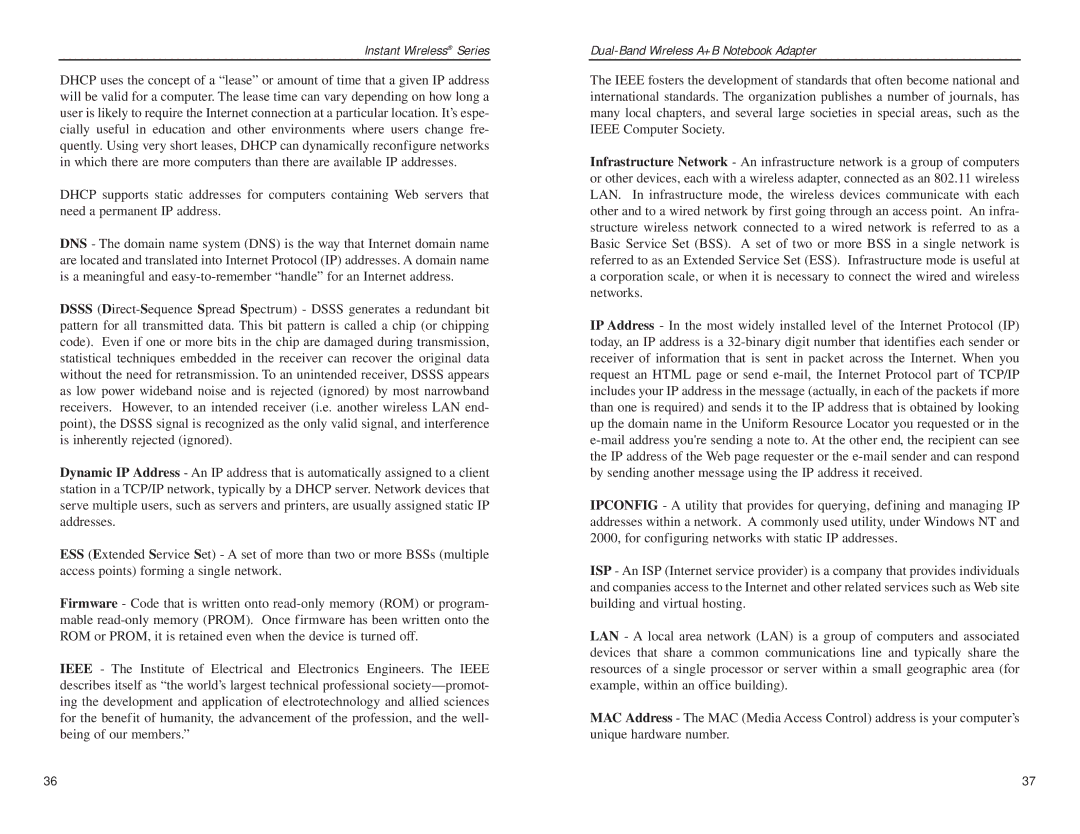Instant Wireless® Series
DHCP uses the concept of a “lease” or amount of time that a given IP address will be valid for a computer. The lease time can vary depending on how long a user is likely to require the Internet connection at a particular location. It’s espe- cially useful in education and other environments where users change fre- quently. Using very short leases, DHCP can dynamically reconfigure networks in which there are more computers than there are available IP addresses.
DHCP supports static addresses for computers containing Web servers that need a permanent IP address.
DNS - The domain name system (DNS) is the way that Internet domain name are located and translated into Internet Protocol (IP) addresses. A domain name is a meaningful and
DSSS
Dynamic IP Address - An IP address that is automatically assigned to a client station in a TCP/IP network, typically by a DHCP server. Network devices that serve multiple users, such as servers and printers, are usually assigned static IP addresses.
ESS (Extended Service Set) - A set of more than two or more BSSs (multiple access points) forming a single network.
Firmware - Code that is written onto
IEEE - The Institute of Electrical and Electronics Engineers. The IEEE describes itself as “the world’s largest technical professional
The IEEE fosters the development of standards that often become national and international standards. The organization publishes a number of journals, has many local chapters, and several large societies in special areas, such as the IEEE Computer Society.
Infrastructure Network - An infrastructure network is a group of computers or other devices, each with a wireless adapter, connected as an 802.11 wireless LAN. In infrastructure mode, the wireless devices communicate with each other and to a wired network by first going through an access point. An infra- structure wireless network connected to a wired network is referred to as a Basic Service Set (BSS). A set of two or more BSS in a single network is referred to as an Extended Service Set (ESS). Infrastructure mode is useful at a corporation scale, or when it is necessary to connect the wired and wireless networks.
IP Address - In the most widely installed level of the Internet Protocol (IP) today, an IP address is a
IPCONFIG - A utility that provides for querying, defining and managing IP addresses within a network. A commonly used utility, under Windows NT and 2000, for configuring networks with static IP addresses.
ISP - An ISP (Internet service provider) is a company that provides individuals and companies access to the Internet and other related services such as Web site building and virtual hosting.
LAN - A local area network (LAN) is a group of computers and associated devices that share a common communications line and typically share the resources of a single processor or server within a small geographic area (for example, within an office building).
MAC Address - The MAC (Media Access Control) address is your computer’s unique hardware number.
36 | 37 |
